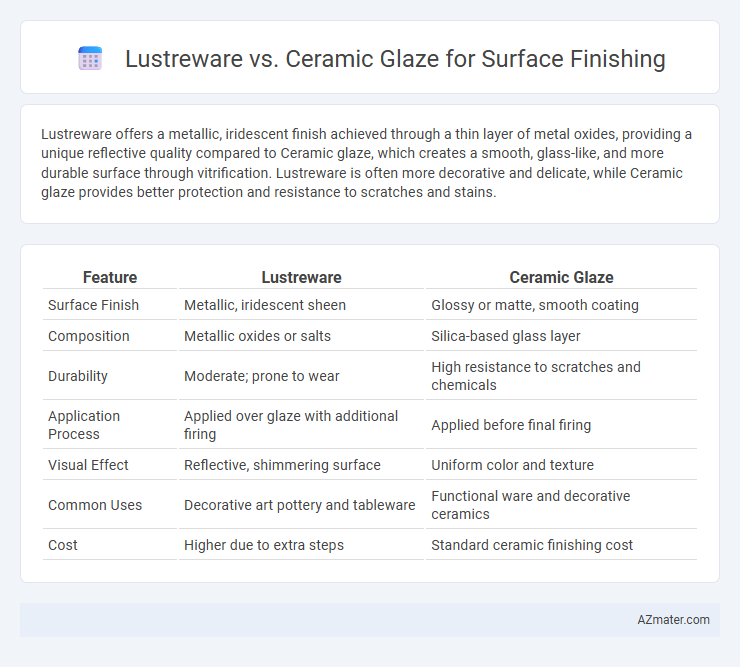Lustreware offers a metallic, iridescent finish achieved through a thin layer of metal oxides, providing a unique reflective quality compared to Ceramic glaze, which creates a smooth, glass-like, and more durable surface through vitrification. Lustreware is often more decorative and delicate, while Ceramic glaze provides better protection and resistance to scratches and stains.
Table of Comparison
| Feature | Lustreware | Ceramic Glaze |
|---|---|---|
| Surface Finish | Metallic, iridescent sheen | Glossy or matte, smooth coating |
| Composition | Metallic oxides or salts | Silica-based glass layer |
| Durability | Moderate; prone to wear | High resistance to scratches and chemicals |
| Application Process | Applied over glaze with additional firing | Applied before final firing |
| Visual Effect | Reflective, shimmering surface | Uniform color and texture |
| Common Uses | Decorative art pottery and tableware | Functional ware and decorative ceramics |
| Cost | Higher due to extra steps | Standard ceramic finishing cost |
Introduction to Lustreware and Ceramic Glaze
Lustreware is a decorative pottery technique distinguished by its iridescent metallic sheen achieved through applying metal oxides and firing in a reduction kiln, creating a thin, reflective glaze layer. Ceramic glaze, in contrast, is a glassy coating fused onto pottery surfaces during firing, enhancing durability, providing waterproofing, and allowing for a wide range of colors and textures. Both finishes serve functional and aesthetic purposes but differ fundamentally in composition, application methods, and visual effects.
Historical Background of Surface Finishes
Lustreware originated in the Islamic world during the 9th century, featuring a metallic sheen achieved through thin layers of metallic oxides fired onto pottery, which later influenced European ceramics in the Renaissance. Ceramic glaze, with roots tracing back to ancient China around 1500 BCE, involves applying a glassy coating of silica, fluxes, and alumina to pottery for durability and decorative effects. Both techniques revolutionized surface finishing by enhancing aesthetic appeal and functionality, shaping the evolution of ceramics across cultures and eras.
Materials Used in Lustreware vs Ceramic Glaze
Lustreware utilizes metallic oxides such as gold, silver, or copper sulfides suspended in an oil-based medium to create its distinctive iridescent sheen, while ceramic glaze primarily consists of silica, fluxes, and alumina that vitrify upon firing to form a hard, glass-like surface. The metallic compounds in lustreware react in a reducing kiln atmosphere to produce a thin, reflective layer, contrasting with ceramic glaze's composition that ensures durability, waterproofing, and color variety through melting and solidification processes. Material selection in lustreware prioritizes light interference effects, whereas ceramic glaze focuses on chemical stability and surface protection.
Application Techniques: Comparing Methods
Lustreware requires applying a thin metallic film over a fired glaze, often through brushing, spraying, or dipping, followed by refiring at a lower temperature to achieve its iridescent finish. Ceramic glaze application involves coating bisque-fired pottery using methods like pouring, spraying, or dipping, then firing at higher temperatures to vitrify and create a durable, glass-like surface. Lustreware's complex refiring process contrasts with ceramic glaze's single-firing step, influencing production time and finish durability.
Aesthetic Effects and Visual Appeal
Lustreware produces a metallic, iridescent finish that reflects light with a shimmering quality, creating a luxurious and dynamic visual appeal ideal for decorative art pieces. Ceramic glaze offers a smooth, glass-like surface available in a wide range of colors and textures, providing durability and a consistent, vibrant finish suitable for functional pottery. Lustreware's unique luster contrasts with the solid, often matte or glossy appearance of ceramic glaze, making each choice distinct in aesthetic effects and surface character.
Durability and Maintenance Considerations
Lustreware features a metallic or iridescent finish that tends to be more delicate and prone to tarnishing or scratching compared to ceramic glaze, which offers a hard, glass-like surface known for exceptional durability. Ceramic glaze provides superior resistance to stains, water, and heat, making it easier to clean and maintain over time without the risk of surface degradation. Maintenance of lustreware requires careful handling and gentle cleaning methods to preserve its shine, while ceramic glazed surfaces can endure regular cleaning with a variety of household detergents without damage.
Cost Comparison and Affordability
Lustreware typically incurs higher production costs due to its intricate metallic finishes and labor-intensive application, making it less affordable than standard ceramic glaze surfaces. Ceramic glaze offers a cost-effective solution with simpler application processes and widespread availability, resulting in lower material and manufacturing expenses. For budget-conscious projects, ceramic glaze presents a more affordable and practical surface finishing option compared to lustreware.
Suitability for Different Ceramics
Lustreware provides a reflective, metallic finish ideal for decorative ceramics such as porcelain and fine earthenware, enhancing intricate designs with its iridescent sheen. Ceramic glaze offers a durable, non-porous coating well-suited for functional ceramics like stoneware and terracotta, providing excellent protection against moisture and wear. Choosing between lustreware and ceramic glaze depends on the intended use and ceramic type, balancing aesthetic appeal with practical durability.
Environmental Impact and Safety
Lustreware uses metallic oxides that can release heavy metals like lead and copper during production and disposal, raising environmental and health concerns. Ceramic glaze typically contains silica, alumina, and fluxes, which are generally safer but may include harmful substances if improperly formulated or fired. Proper kiln temperature control and sourcing non-toxic raw materials reduce environmental impact and enhance safety for both finishing methods.
Choosing the Right Finish for Your Project
Lustreware offers a distinctive, reflective sheen created from metallic oxides, ideal for decorative projects seeking a vintage or luxurious appearance. Ceramic glaze provides a durable, protective coating that enhances surface hardness and resistance to stains and scratches, making it suitable for functional items like dinnerware. Selecting between lustreware and ceramic glaze depends on whether aesthetic appeal or durability is the priority for your specific application.

Infographic: Lustreware vs Ceramic glaze for Surface finishing
 azmater.com
azmater.com